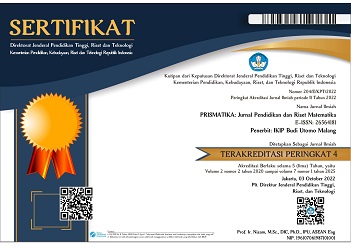KARAKTERISTIK ANALOGI SISWA SEKOLAH DASAR DALAM PENGAJUAN MASALAH LUAS DAERAH
Abstract
This study aims to identify the characteristics of elementary school students' analogies in proposing area problems. The method used in this research is descriptive qualitative using a case study approach. The characteristics of analogy in the submission of area problems can be categorized into three: (1) Identical-reformulation is rearranging the elements in the problem structure in ways that do not change the nature of the problem. (2) Identical-different-reconstruction is modifying and maintaining some elements of the form in the initial problem so that the resulting problem looks slightly different. (3) Different-imitation is changing and adding new shape elements that are not in the initial problem to produce a different problem. The results of the research showed that the characteristic most often found in students is imitation, where the problem produced is different from the initial problem given. So the different imitation characteristics that appear most often correspond to replacement characteristics, namely the problem posing product based on the initial problem or source problem by changing the context of the problem, namely changing the shape of the cake slice.
References
Akmalia, N. N., Pujiastuti, H., & Setiani, Y. (2016). Identifikasi Tahap Berpikir Kreatif Matematis melalui Penerapan Model Problem Based Learning dengan Tugas Pengajuan Masalah. JPPM, 9(2), 183–193.
Alfansyur, A., & Mariyani. (2020). Seni Mengelola Data : Penerapan Triangulasi Teknik , Sumber dan Waktu pada Penelitian Pendidikan Sosial. Historis: Jurnal Kajian, Penelitian & Pengembangan Pendidikan Sejarah, 5(2), 146–150.
Arvianto, I. R. (2018). Proses Berpikir Kreatif Mahasiswa dalam Pengajuan Masalah Matematika Ditinjau dari Perbedaan Gender. JIPM (Jurnal Ilmiah Pendidikan Matematika), 6(2), 99. https://doi.org/10.25273/jipm.v6i2.2180
Azmi, M. P. (2019). Analisis Pengembangan Tes Kemampuan Analogi Matematis pada Materi Segi Empat. Juring (Journal for Research in Mathematics Learning), 2(2), 099. https://doi.org/10.24014/juring.v2i2.7490
Dita, F., & Siswono, T. Y. E. (2019). Strategi Peserta Didik dalam Mengajukan Masalah Matematika. E-Journal Unesa, 8(3), 512–516.
Gentner, D., & Maravilla, F. (2017). Analogical Reasoning. International Handbook of Thinking and Reasoning, 186–203. https://doi.org/10.4324/9781315144016-14
Handayani, T. (2021). Model Pembelajaran Discovery Learning pada Materi Luas dan Keliling Bangun Datar Kelas VI Sekolah Dasar. Jurnal Pembelajaran Prospektif, 6(1), 39–45. https://doi.org/10.26418/jpp.v6i1.45788
Harahap, N. (2020). Penelitian Kualitatif (H. Sazali (ed.); 1st ed.). Wal Ashri Publishing.
Kojima, K., Miwa, K., & Matsui, T. (2013). Supporting Mathematical Problem Posing with a System for Learning Generation Processes through Examples. International Journal of Artificial Intelligence in Education, 22(4), 161–190. https://doi.org/10.3233/JAI-130035
Kojima, K., Miwa, K., & Matui, T. (2010). Experimental Study for Design of Computational Learning Support to Enhance Problem Posing. Proceedings of the 18th International Conference on Computers in Education: Enhancing and Sustaining New Knowledge Through the Use of Digital Technology in Education, ICCE 2010, 92–94.
Moshinsky, M. (2017). Mathematical Creativity and Giftedness. In D. Pitta & Pantazi (Eds.), Department of Education, University Of Cyprus (Vol. 10, Issue 1). Department of Education, University of Cyprus.
Mutia, Kartono, Dwijanto, & Wijayanti, K. (2022). Peran Kemampuan Berpikir Kreatif Matematis dan Penalaran Analogi dalam Pembelajaran Matematika Guna Memenuhi Tuntutan Perkembangan Abad 21. Prosiding Seminar Nasional Pascasarjana Universitas Negeri Semarang, 741–749. https://proceeding.unnes.ac.id/index.php/snpasca/article/view/1559.
Nurwahid, M. (2021). Analisis Kesalahan Siswa SD dalam Menyelesaikan Permasalahan Luas Gabungan Bangun Datar Berdasarkan Watson’s Error Category. Journal on Education, 3(4), 308–319. https://doi.org/10.31004/joe.v3i4.388.
Prasetyo, A., & Rosyidi, A. H. (2021). Penalaran analogi siswa sma dalam pengajuan masalah setelah solusi. Jurnal Ilmiah Pendidikan Matematika, 10(1), 45–58. https://jurnalmahasiswa.unesa.ac.id/index.php/mathedunesa/article/view/25554/23429
Ridhoi, M., Sulandra, I. M., Sukoryanto, & Nusantara, T. (2020). Analisis Kemampuan Penalaran Analogi Siswa SMP dalam Menyelesaikan Masalah Matematika. Jurnal Pendidikan Matematika dan Sains, 8(1), 21–25. https://doi.org/http://dx.doi.org/10.21831/jpms.v8i1.19649.
Silver, E. A. (1994). On mathematical problem posing. For the Learning of Mathematics, 1(14), 19.
Stoyanova, E. (2005). Problem-posing Strategies Used by years 8 and 9 Students. Australian Mathematics Teacher, 61(3), 6–11. http://www.freepatentsonline.com/article/Australian-Mathematics-Teacher/164525411.html
Sulistiani, I. R. (2013). Pembelajaran Luas Daerah Persegi Panjang Berdasarkan Standar Pengajaran National Council Of Teachers of Mathematics (NCTM) untuk Meningkatkan Pemahaman Siswa Kelas III SDN Dinoyo I Malang. Jurnal Fourier, 1(1), 11. https://doi.org/10.14421/fourier.2012.11.11-16.
Wahyuni, A. S., Siswono, T. Y. E., & Mariana, N. (2022). Profil Berpikir Kreatif Siswa Sekolah Dasar dalam Mengajukan Masalah Matematika Konteks Museum Gubug Wayang. Jurnal Basicedu, 6(1), 759–766. https://doi.org/10.31004/basicedu.v6i1.2093
Zeybek, Z., & Francis, D. I. C. (2017). Let’s Cut the Cake. Teaching Children Mathematics, 23(9), 542–548 https://doi.org/10.5951/teacchilmath.23.9.0542







.png)




